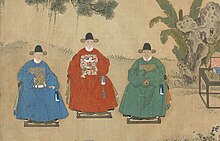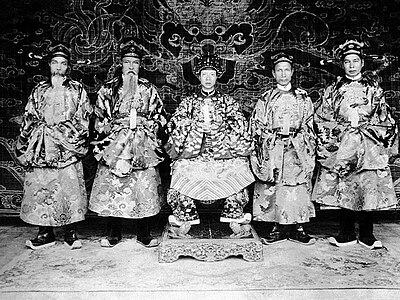Futou
This article needs attention from an expert in China or History. (October 2019) |

Futou (襆頭), also known as putou (幞頭), is a Chinese form of hat which was typically worn by government officials.[1] The futou was originally a turban; when the turban was tied at the back of its wearer's head, the two corners would go to the opposite directions thus acting as decorations.[2] With time, the futou came to assume a variety of shapes and styles.[3]
Terminology[]
The term putou means "head scarf" or "head-cloth".[3]
History[]
Wei, Jin, Northern and Southern dynasties[]
The putou was originally a turban-like headgear; it first appeared in the 3rd century AD and was based on the headdress of a northern tribe.[3] It is also proposed that putou may have been developed from hats worn in ancient Central Asia and was brought in by the Turks from Sogdiana to Tokharistan to China.[4]
In Northern Zhou, Emperor Wu wrapped his head with a futou, which consisted of 4 ribbons, 2 of which were tied at the back and left hanging down, while the other 2 were tied at the top of the head.[5] The futou made by Emperor Wu had to cover the entire head of its wearer and had two ribbons which would be tied behind the wearer's head.[5]
Tang dynasty[]
By the Tang dynasty, the futou developed and a ribbon was attached to each corner of the turban; by adding wire or silk strings inside the ribbon, the futou could take different shapes and styles depending on the its wearer's liking.[2]
Chuijiao Putou[]
Chuijiao Putou (Chinese: 垂腳襆頭) was a black hat with two drooped down wing-like flaps.

Chuijiao putou
Ruanjiao putou[]
There was a type of putou called ruanjiao putou (simplified Chinese: 软脚幞頭; traditional Chinese: 軟腳幞頭; pinyin: ruǎnjiǎo fútóu; lit. 'putou with soft legs'), also known as zheshang jin (Chinese: 折上巾; lit. 'kerchief folded upward'), which consisted of square-piece of cloth wrap around the head; the two ends of the fabric were then tied at the back at either side of the neck and were then wrapped around the head before being together above the forehead.[3] Sometimes, 2 or 4 narrow and long ribbons were tied to the back of the putou and were allowed to hang down freely down the back of its wearer.[3] The ruanjiao putou was a typical type of headwear in the Tang dynasty.[3]
Song dynasty[]
During the Song dynasty, all classes of people ranging from commoners to emperors wore futou.[6]
There were 5 main types of futou: "straight-feet" futou (also called "flat-feet") which was worn by people of all social classes; "bent-feet" futou, "cross-feet" futou (Chinese: 交脚幞頭), "upward" futou and "downwind" futou.[6] The term "feet" (simplified Chinese: 脚; traditional Chinese: 腳; pinyin: jiao; lit. 'feet') is used to describe the hard ribbons used in the futou.[6]
In the early Song dynasty, a type futou which was folded and tied at the front region of the head was worn by some people.[6] This type of futou was called the "front-folded scarf".[6]
The "back-folded scarf", a type futou which would be bent backward, started to be worn after the Shaosheng period.[6]
During imperial court banquets, Song court officials would put flowers on their futou; this is referred as Flower pinning.[6]
Zhanjiao putou[]
Zhanjiao Putou (展角幞頭), lit. "spread-horn head cover", is a type of futou worn in the Song dynasty.
Ming dynasty[]
Zhanchi Futou[]
Zhanchi Futou (展翅襆頭) or Zhanchi Putou, also known as the wushamao (烏紗帽), is the headwear of Ming dynasty officials, consisting of a black hat with two wing-like flaps of thin, oval shaped boards on each side. According to the Collected Statutes of the Ming Dynasty (大明會典), ordinary citizens are not allowed to wear this headdress unless attending wedding ceremonies or events involving any noble families/officials. In modern China, wushamao is commonly used as a metaphor for officials and government posts. The Zhanchi Futou was also adopted by neighbouring countries.

Japan's Toyotomi Hideyoshi wearing a hat influenced by wushamao(烏紗帽)

Joseon's Sim Hwan-ji wearing a hat influenced by osamo(烏紗帽)

Vietnam's Trần Danh Án wearing a "ô sa mạo" hat influenced by wushamao (烏紗帽)

Emperor Khải Định (middle) and mandarins wearing "ô sa mạo" 烏紗帽)
See also[]
- Hanfu
- Hanfu headgear
- Qing official headwear
- List of hats and headgear
References[]
- ^ Dale R. Johnson (2020). A Glossary of Words and Phrases in the Oral Performing and Dramatic Literatures of the Jin, Yuan, and Ming. University of Michigan Center for Chinese Studies. p. 73. ISBN 978-0-472-03823-7. OCLC 1229843176.
- ^ Jump up to: a b Zang, Yingchun; 臧迎春. (2003). Zhongguo chuan tong fu shi. 李竹润., 王德华., 顾映晨. (Di 1 ban ed.). Beijing: Wu zhou chuan bo chu ban she. ISBN 7-5085-0279-5. OCLC 55895164.
- ^ Jump up to: a b c d e f Burkus, Anne Gail (2010). Through a forest of chancellors: fugitive histories in Liu Yuan's "Lingyan ge", an illustrated book from seventeenth-century Suzhou. Yuan, active Liu. Cambridge, Mass. p. 319. ISBN 978-1-68417-050-0. OCLC 956711877.
- ^ Stepanov, T︠S︡vetelin (2010). The Bulgars and the steppe empire in the early Middle Ages: the problem of the others. Leiden, Netherlands: Brill. p. 55. ISBN 978-90-474-4452-7. OCLC 695988846.
- ^ Jump up to: a b Zhu, Ruixi; 朱瑞熙; Bangwei Zhang, Fusheng Liu, Chongbang Cai, Zengyu Wang, Peter Ditmanson, Bang Qian Zhu (2016). A social history of middle-period China: the Song, Liao, Western Xia and Jin dynasties (illustrated ed.). Cambridge, United Kingdom. p. 10. ISBN 978-1-107-16786-5. OCLC 953576345.CS1 maint: multiple names: authors list (link)
- ^ Jump up to: a b c d e f g Zhu, Ruixi; 朱瑞熙 (2016). A social history of middle-period China : the Song, Liao, Western Xia and Jin dynasties. Bangwei Zhang, Fusheng Liu, Chongbang Cai, Zengyu Wang, Peter Ditmanson, Bang Qian Zhu (Illustrated ed.). Cambridge, United Kingdom. p. 11. ISBN 978-1-107-16786-5. OCLC 953576345.
- Chinese headgear
- Ming dynasty
- Chinese history stubs
- Clothing stubs







